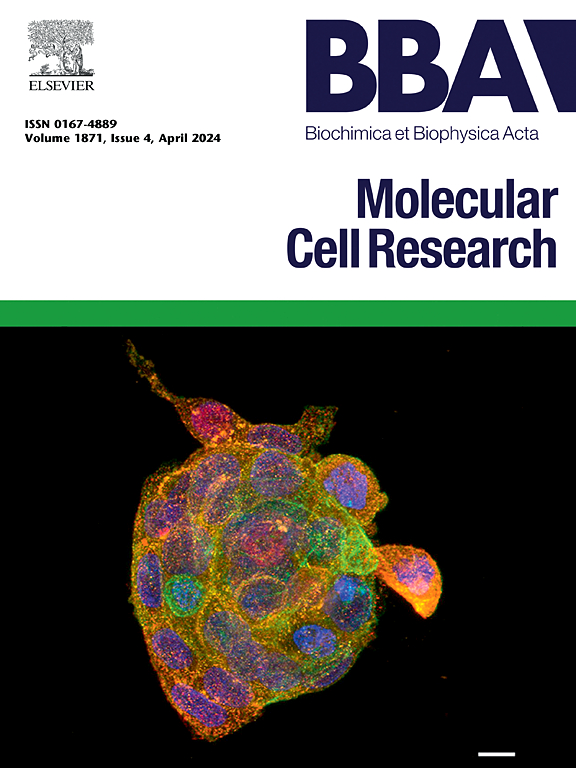Activation and signaling characteristics of the hydroxy-carboxylic acid 3 receptor identified in human neutrophils through a microfluidic flow cell technique
IF 4.6
2区 生物学
Q1 BIOCHEMISTRY & MOLECULAR BIOLOGY
Biochimica et biophysica acta. Molecular cell research
Pub Date : 2025-04-05
DOI:10.1016/j.bbamcr.2025.119950
引用次数: 0
Abstract
Human neutrophils express numerous G protein-coupled receptors (GPCRs) of importance for immune regulation. However, several functionally characterized neutrophil GPCRs, are not included within the human neutrophil proteome. To identify GPCRs not previously demonstrated to be expressed in human neutrophils, we utilized a microfluidic flow cell technique in conjunction with subcellular granule fractionation and liquid chromatography-tandem mass spectrometry (LC-MS/MS). This approach led to the identification of hydroxy-carboxylic acid 3 receptor (HCA3R, also known as GPR109B) as a novel component of the human neutrophil proteome. The β-oxidation intermediate 3-hydroxy-octanoic acid (3-OH-C8) is the primary endogenous agonist of the HCA3R and expressed at high levels in adipocytes where it exerts anti-lipolytic effects. However, literature describing the role and function of HCA3R in human neutrophils is scarce. We show that 3-OH-C8, as well as the synthetic HCA3R agonist IBC 293, activate human neutrophils determined as an increase in the intracellular concentration of free calcium ions ([Ca2+]i) and activation of the NADPH oxidase. However, in contrast to the rise in [Ca2+]i, which could be triggered in naïve neutrophils, pre-treatment of neutrophils was required for the HCA3R agonists to activate the NADPH oxidase. That is, the HCA3R-mediated NADPH oxidase activation occurred only in neutrophils pre-treated with either an actin cytoskeleton disrupter or an allosteric modulator targeting the GPCR termed free fatty acid receptor 2 (FFA2R). Our findings demonstrate that HCA3R is not only a new member of the human neutrophil proteome but also exhibits functional activity with complex signaling pathways when stimulated with endogenous and synthetic HCA3R agonists.

人类中性粒细胞表达许多对免疫调节非常重要的 G 蛋白偶联受体(GPCR)。然而,人类中性粒细胞蛋白质组中并不包括几种具有功能特征的中性粒细胞 GPCR。为了鉴定以前未在人类中性粒细胞中表达的 GPCR,我们采用了微流体流动池技术,并结合亚细胞颗粒分馏和液相色谱-串联质谱法(LC-MS/MS)。这种方法鉴定出羟基羧酸 3 受体(HCA3R,又称 GPR109B)是人类中性粒细胞蛋白质组中的一种新成分。β-氧化中间体 3-羟基辛酸(3-OH-C8)是 HCA3R 的主要内源性激动剂,并在脂肪细胞中高水平表达,发挥抗脂解作用。然而,描述 HCA3R 在人类中性粒细胞中的作用和功能的文献却很少。我们的研究表明,3-OH-C8 以及合成的 HCA3R 激动剂 IBC 293 能激活人中性粒细胞,表现为细胞内游离钙离子浓度([Ca2+]i)的增加和 NADPH 氧化酶的激活。然而,与[Ca2+]i 的升高可在天真中性粒细胞中触发不同,HCA3R 激动剂激活 NADPH 氧化酶需要对中性粒细胞进行预处理。也就是说,HCA3R 介导的 NADPH 氧化酶活化只发生在使用肌动蛋白细胞骨架破坏剂或针对称为游离脂肪酸受体 2(FFA2R)的 GPCR 的异位调节剂预处理的中性粒细胞中。我们的研究结果表明,HCA3R 不仅是人类中性粒细胞蛋白质组中的新成员,而且在内源性和合成 HCA3R 激动剂的刺激下,还表现出具有复杂信号通路的功能活性。
本文章由计算机程序翻译,如有差异,请以英文原文为准。
求助全文
约1分钟内获得全文
求助全文
来源期刊
CiteScore
10.00
自引率
2.00%
发文量
151
审稿时长
44 days
期刊介绍:
BBA Molecular Cell Research focuses on understanding the mechanisms of cellular processes at the molecular level. These include aspects of cellular signaling, signal transduction, cell cycle, apoptosis, intracellular trafficking, secretory and endocytic pathways, biogenesis of cell organelles, cytoskeletal structures, cellular interactions, cell/tissue differentiation and cellular enzymology. Also included are studies at the interface between Cell Biology and Biophysics which apply for example novel imaging methods for characterizing cellular processes.

 求助内容:
求助内容: 应助结果提醒方式:
应助结果提醒方式:


